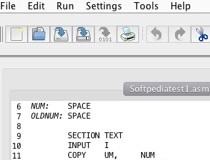Did you know NASA just landed a 22-year-old Bondi Blue iMac on Mars? It’s true! It’s just tucked away under the hood of this incredible piece of engineering, the Perseverance Rover!

I assuming they scrapped the case to save on weight…
Assembly mips mips32 mars-simulator. Follow edited Jan 19 at 21:13. 244k 34 34 gold badges 421 421 silver badges 600 600 bronze badges. MARS is a lightweight interactive development environment (IDE) for programming in MIPS assembly language, intended for educational-level use with Patterson and Hennessy's Computer Organization and Design. MARS has been jointly developed by Pete Sanderson (programming) and Ken Vollmar (details and paperwork). Code in the MIPS Assembly Language by turning to this lightweight interactive development environm. MARS (MIPS Assembler and Runtime Simulator) is described as 'MARS is a lightweight interactive development environment (IDE) for programming in MIPS assembly language, intended for educational-level use with Patterson and Hennessy's' and is an app in the Development category.
Old G3 iMac Landed On Mars
Ok ok.. so NASA did not take an actual iMac G3 and stuff it into the Perseverence Rover, BUT, it has the same brain! The original 1998 Bondi Blue iMac the revolutionized computing was powered by a 233Mhz PowerPC 750 processor, capable of eye melting 525 MIPS!
And a current AMD Ryzen 9 3950X is capable of 749,070 MIPS.
Mars Mips Compiler
That is 4,286% slower… surprising for a spacecraft that reached 39,000KPH on its way to the Red Planet.
Why would Perseverance Rover, the single most advanced planetary rover produced by humanity use such a crap processor?? So many reasons!
- Proven technology – has been on market for ages and known not to fail, no concern about bugs being discovered later!
- No need for speed – This rover is not running the latest copy of Cyberpunk 2077 out there.
- Simpler architecture – Fewer parts (10.4 million transistors compared to nearly 4 billion for the Ryzen)
- Power consumption – Fewer transistors and such means it uses less power, incredibly important for spacecraft – but nuclear-powered ones?
- Design time – This equipment has been on the drawing board for decades – this PowerPC 750 was amazing at the time!
- Radiation Hardening – Oh yea, this one is built like a TANK. It achieves radiation hardness of 1E-11 upsets/bit-day – those specs are beyond me.
So yea, though it’s been built specifically to survive dodging Klingons in the coldness of space, that is the same damn processor found in my 1998 iMac! Just much less affordable, $250,000 a pop would have impacted Apple sales significantly.
Ancient, Proven Technology Common In Space
Common sense would make us believe the latest in NASA engineering should be using Quantum Computers already, the latest bleeding-edge technology out of Skunkworks or DARPA, but no, it’s like the Enterprise is fighting the Borg with over-clocked Intel i9 processors in their computer cores. The biggest reason is simply that durability and fact they are proven to be reliable.
Photoshop budget has been blown on this post, we apologize for the poor quality of further silly graphics.
Though I’d sign up for it, it’s pretty difficult for NASA to send Geek Squad out to Mars to swap a processor if a critical flaw is found like the Intel Converged Security Management Engine (CSME). Finding something like that, later on, could prove absolutely fatal to such a complex mission. It’s much more beneficial to use something that is known transistor by transistor, something that is known to be incredibly stable, something you don’t have to worry about crapping the bed 220 million clicks away.

Mars Mips Assembly
When you are going to have computer hardware travel through the harshness of space, suffer the incredible rough entry into a planetary atmosphere and survive in a radiation heavy environment like Mars, you want to be assured of your hardware. But, NASA is always prepared, there are two of those (well, three, one used for image analysis) processor modules onboard, one for backup.
NASA is such a fan of this processor package, they used it on board Curiosity, Fermi Space Telescope, Lunar Reconnaissance Orbiter, Deep Impact spacecraft, and the Kepler telescope, and I’m sure it will be used again.
Mars Mips Array
We may kid about the weaksauce Perseverance has for brains, but the truth is this thing screams compared to the other Mars rovers; Pathfinder and the Spirit/Opportunity twins had a 20Mhz processor with 128MB of RAM. Both of these left Sojourner in the martian dust, it clocked at 2Mhz!
Perseverance Rover is not the first Mac on Mars either! When I was in High School, I was excited to see the first PowerPC Macs come into the lab in ’94, a beautiful pizza box-shaped Power Mac 6100! Little did I know that 10 years later I would see two of them trundling around the surface of Mars!

Mars Mips Macros

Mars Mips Machine
Anything to say about this article? Contact us!
- 2021 iMac – Aluminum Is The New Beige - May 5, 2021
- iOS 14.5 – The Pandemic Update A Year Late - April 26, 2021
- Apple AirTags – Soon To Be The Most Prolific Apple Product - April 24, 2021